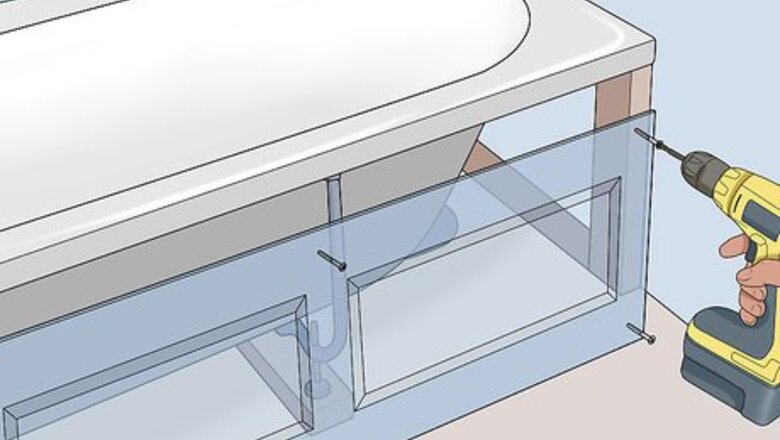
views
- Measure the length and height of your tub and cut your bath panel to size with a handsaw.
- Screw the clips included with your panel into the underside of the lip of the tub, placing 1 in the middle and at least 1 on each end.
- Push the panel into place, securing it with the clips. Press gently on various parts of the panel to ensure it's secure.
Measuring and Trimming the Bath Panel
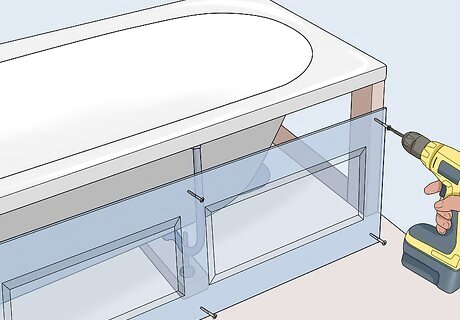
Remove the old bath panel if yours has one. In most cases, it will just pull out. Use a flat head screwdriver or a crowbar to get under the edge pf the panel at the bottom or on one side. Leverage one edge of the bath panel out until you can get your fingers under it, and then keep pulling on it with your hands until it comes away from the tub. Some may be screwed in at the bottom. If yours is, just use a screwdriver or drill to take the screws out, then pry the panel out.
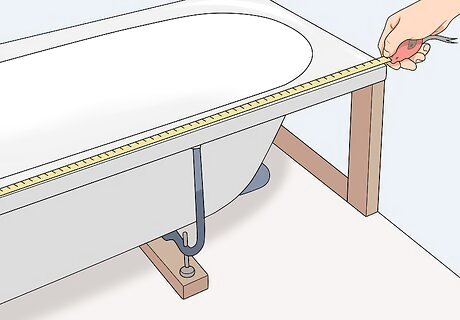
Measure the bath with a tape measure. Run the tape measure along the top edge of the bath where the panel will go on the single open side. That will be the length you need. Then, run the tape measure from the floor up to just under the top edge of the bath, which will be the height.
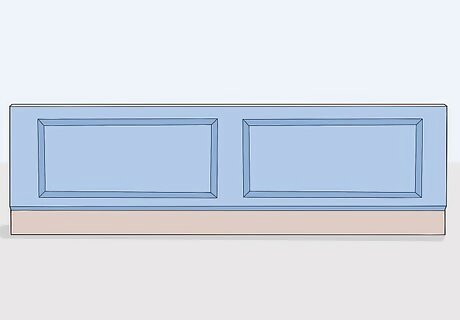
Choose a bendable acrylic type for a single side or rounded corner. This type is the easiest to install, and it works around curves if you have an awkwardly shaped tub. It's not as durable or sturdy as other types of panels, but it will fit most bath tubs. Make sure the panel is the same size or larger than the opening.
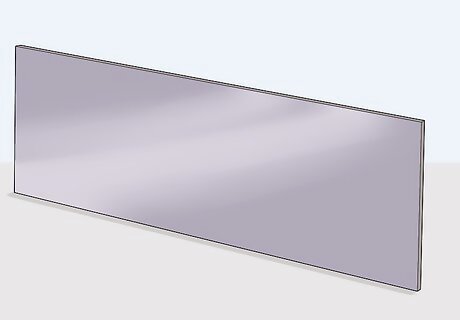
Pick a rigid panel for more durability. These panels come in either wood or acrylic, based on your visual preference. Acrylic tends to be more waterproof, if that's a concern for you. These will only work on straight edges, but you can install them on 2 sides if you need to cover more than one edge. Try to find a panel that fits your bath perfectly. If you can't, select one that's larger and trim it to size.
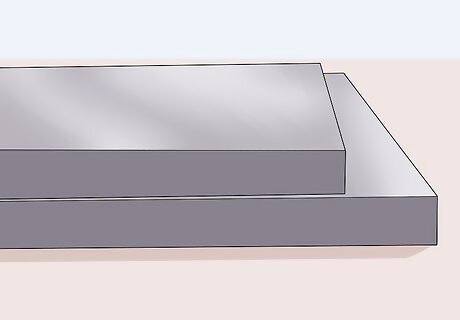
Adjust the height of the plinth if your panel has one. Some bath panels, typically wooden ones, come with a "plinth," which is a plank that screws in along the bottom of the panel. It overlaps the main panel so you can move it up and down to adjust the height. Lay the plinth on the floor and then place the edge of the panel on top so they're overlapping. Move the panel up and down on the plinth until the height reaches the measurement you took for your opening. To measure the height, run the tape measure from the top of the panel to the bottom of the plinth. Screw the panel into the plinth by placing screws every 1 foot (0.30 m) or so on both the top and bottom of the plinth. For added water protection, apply a layer of silicone between the plinth and the panel. Unscrew the panel and run the tip of a silicone tube back and forth all along the inside. Make sure to add a small dollop to the screw holes, too, then put the whole thing back into place. You need to screw it together first because you need to add silicone to the screw holes you create when you put it together.
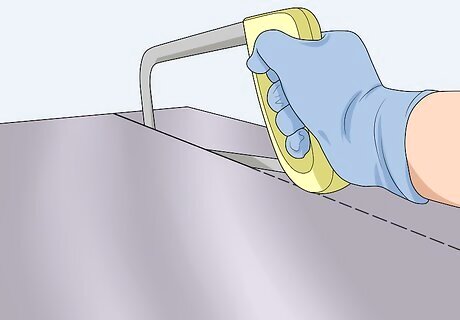
Cut the panel if you need it to be shorter or not as wide. You can use a hacksaw for this purpose. Make sure to put it in place first to see if it fits, and then measure twice to ensure you've got the right size. Mark a line along the panel on the back side and gently saw back and forth down the line to cut the piece off. Make sure to cut along the non-decorative edges. For instance, some panels have a decorative edge along the top, so you don't want to cut that off. You can also use a circular saw to cut it if you have one. Set the panel in place to see if it fits by placing it into the opening on the side of the bath. Tip it under the top edge and slide it into place at the bottom. If you see anything that needs to be adjusted, use the hacksaw to make changes. For instance, if the floor is uneven, cut off part of the bottom of the panel to ensure it fits.
Installing Bendable Acrylic Panels with Clips
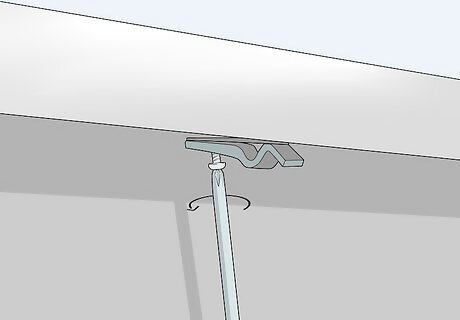
Screw the clips into place underneath the top edge of the tub. Find the clips that came with your paneling. Place a clip underneath the tub's upper edge with the opening of the clip facing out, putting the flat side of the clip up against the underside of the tub edge. Hold the clip in place, and then drill a screw into the clip's hole to attach it to the tub. Place at least one clip in the middle and one on each end. If you want, you can use a drill for this purpose. Drilling pilot holes (making a hole before you add the screw) may make it easier, but make sure you don't drill all the way through the top of the tub. If your panel didn't come with clips, ask for acrylic panel tub clips at your local home improvement store.
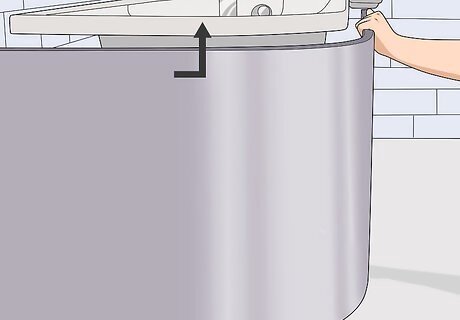
Turn the panel so it's right-side up. Position the panel so the finished side faces outward and the lip at the top is facing inward toward the clips you've installed. Curve the panel as needed to make it go around the end of the tub.
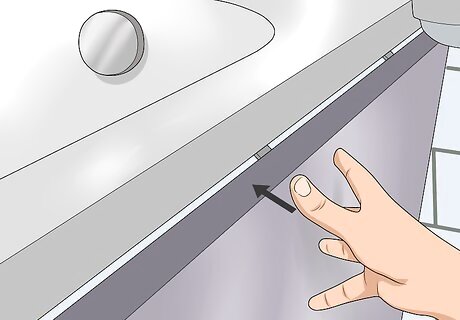
Push the panel into place using the clips. Slide the panel toward the tub, making sure you've got it even on both ends. The top of the panel will slide just under the edge of the tub. These panels have a lip at the top thin enough to go into the clips. Push along the top of the panel so the lip slides into the clips. Listen for a "clicking" noise as the panel fits into place.
Making a Frame for Stiff Panels
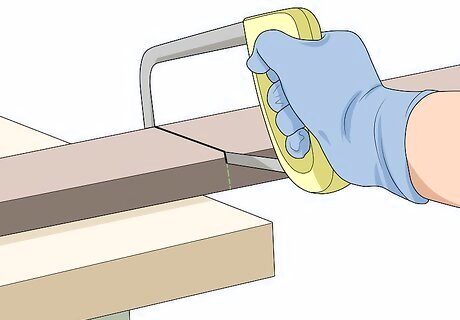
Cut a piece of rebated timber for each side. If you just have one side to add a panel to, cut it to fit that side using a hacksaw. If you're fitting 2 panels, one on each open side of a corner tub, trim a piece for each side. You can purchase this type of timber already cut this way. This type of wood just has a piece cut out of it on one side so that the lip of the panel will fit under it. If you're looking at it from the end, one quarter of the piece of wood will be missing, creating the space the lip of the panel can slide under. You'll use wood footing whether your panel is wood or stiff acrylic.
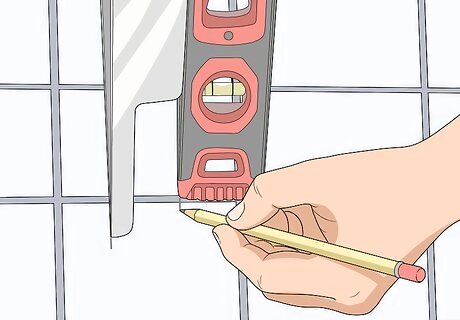
Draw lines where the panel sits on the floor. Tip the panel underneath the top edge of the tub and slide the bottom in place. Place a level against the side of the tub to make sure it's sitting upright. With a pencil, mark where each edge of the panel hits the floor. Do the same on both ends and repeat with the second panel if you have one.
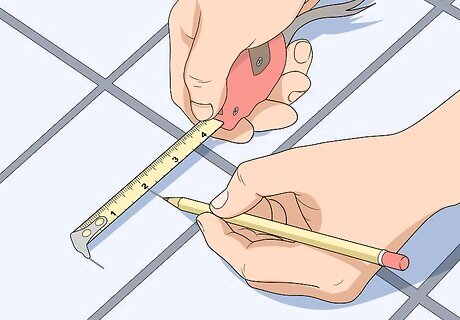
Check the placement of the wood footing and mark it on the floor. Set the wood on the back side of the panel on the floor. Position the rebated portion so it's facing the floor and pointed toward the panel. Slide the panel underneath the lip of the wood. With the panel in its appropriate place, mark where the edge of the wood should be on the floor. You're marking it so you know where to screw it into after you pull the panel out. You can only do this if you have an opening on 2 sides, as you'll be able to look at the panel and wood from the side. Otherwise, measure the width of the panel and the wood when they're placed up against each other away from the tub. After marking the outer edge of the panel on the floor when its fitted in place, use the width measurement you just took to mark where the wood should go underneath the tub after removing the panel.
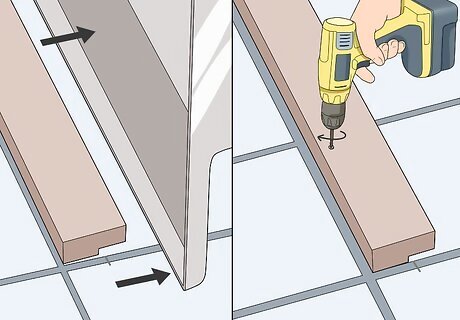
Move the panel out of the way and screw the timber in place. Mark holes to go through just the wood side of the brace with 1 near each end of the wood and at least 2 in between the ends. Drill holes through the wood into the tile or wood floor below using a drill bit. You may need to move the wood to continue the pilot hole into the floor. These holes should be the same size as your screws. Set the wood where it needs to go on top of these holes, then drill screws through the holes and into the floor to hold the footing in place. Use wood screws that are long enough to go through the rebated timber and into the floor; they'll need to be at least 1 inch (2.5 cm). Opt for ⁄8 in (3.2 mm) screws. Screw them into the holes you've made. Always run an electric detector over the floor to look for pipes and wires. You don't want to drill through those!
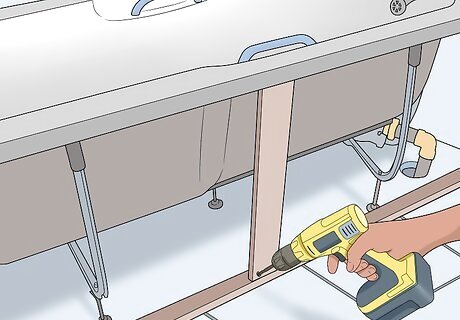
Add a vertical brace for heavier panels. Some panels, such as those made of wood, may need a bit more bracing because they are so heavy. In that case, a single piece of wood is likely all you need. Use a 3 in (7.6 cm) wide piece of wood. Measure from underneath the edge of the tub to the floor and cut the wood to size with a hacksaw. Hold the piece in place, making sure it's flush with the other pieces of wood at the front. Drill 2 wooden screws in at a 45-degree angle toward the floor at the bottom, going through the side and footing into the floor. Drill 2 shorter screws into the wood underneath the lip of the tub, also going at a 45-degree angle. Check to make sure this piece feels solid before moving on. If you prefer, you can add some adhesive hook and loop strips to the timber. Put one adhesive side on the wood and attach the other side of the loop and hook strip to it. Peel off the backing so it attaches to the panel when you slide it into place. That will help the panel stay put.
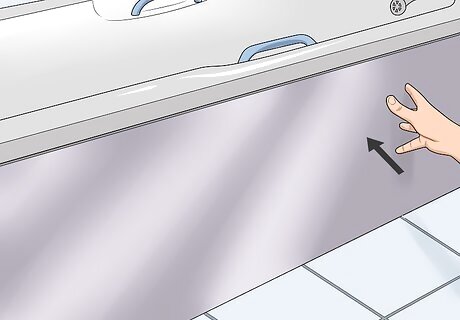
Fit the panel into place. Tip the top of the panel down so the lip goes underneath the edge of the tub on the outside. Push the bottom edge in so the panel straightens up, and then keep pressing until it hits the wood that you've screwed into the floor. Do the same with the panel on the end, if yours has one. That completes the installation.

















Comments
0 comment